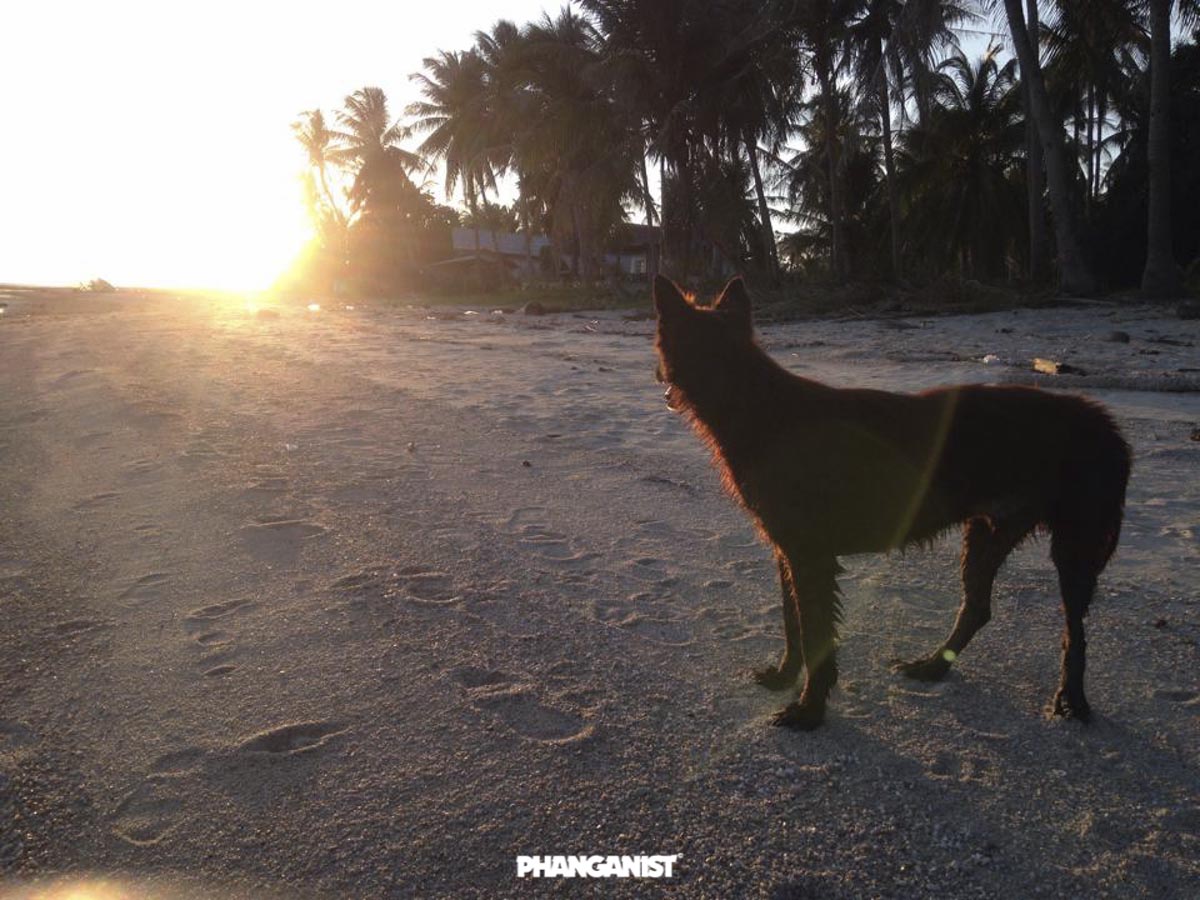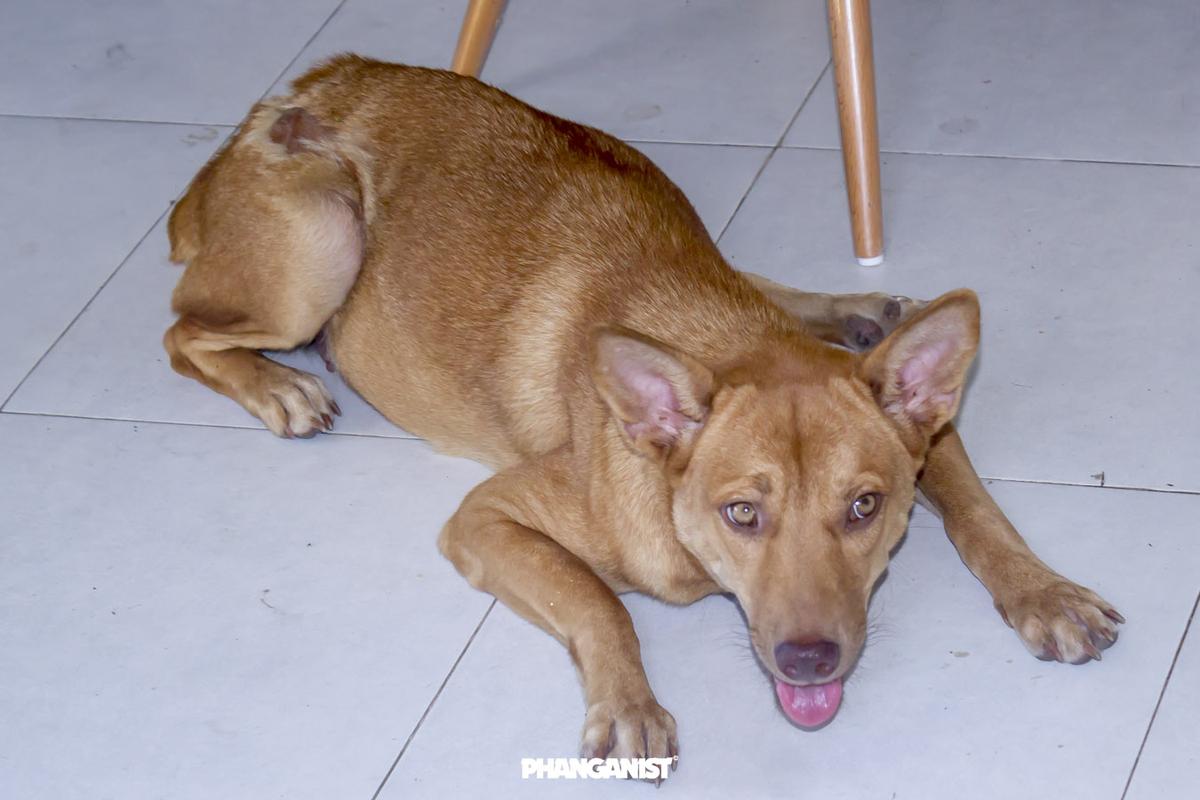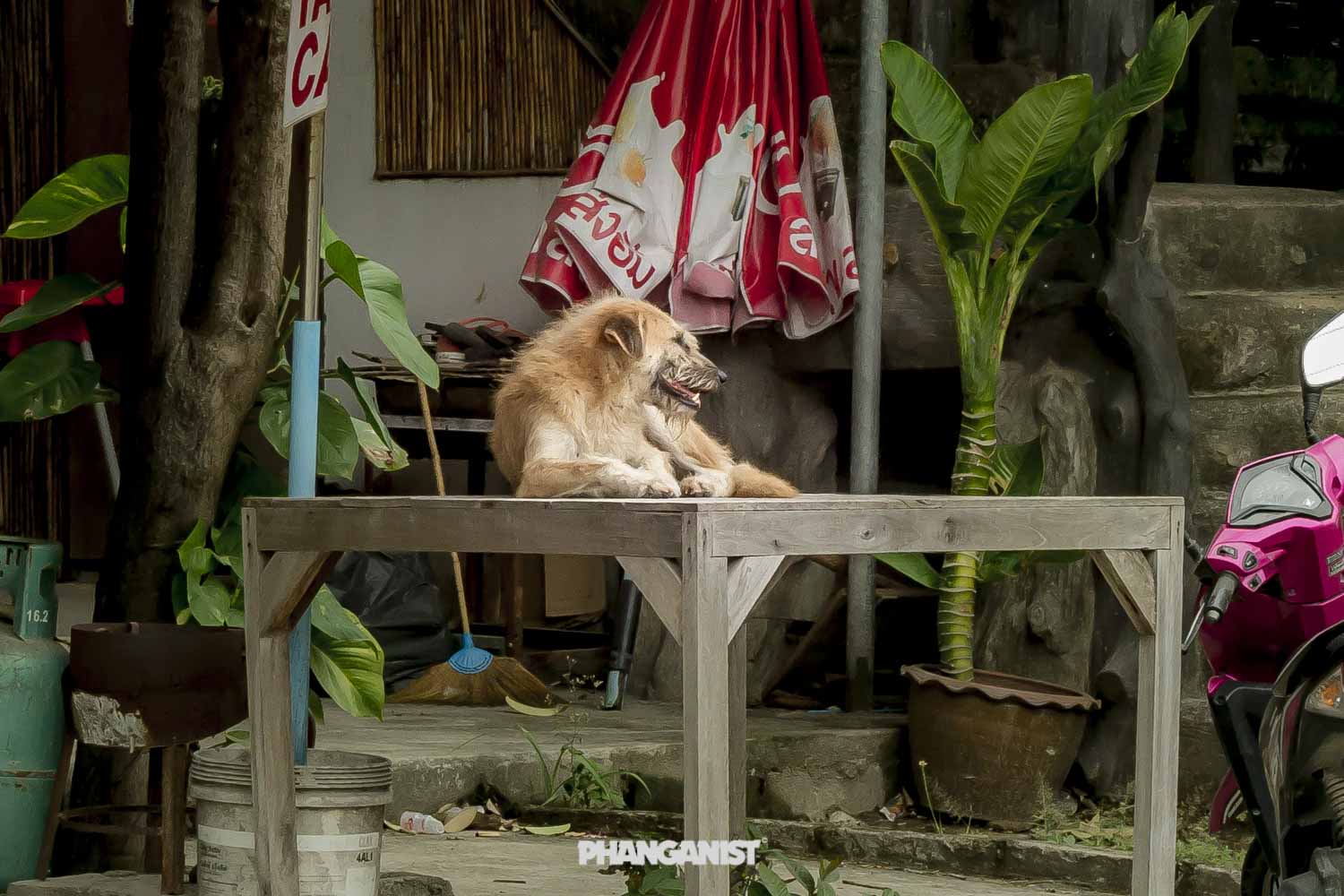On Koh Phangan, you will likely come across stray, sick or injured dogs. Some of these dogs live happily on the streets or may have just wandered away from home, some might be lost or need of help and so what do you do in these situations?
Here is a useful Q&A which is worth reading so that you have the knowledge to deal with situations in future too.

What do I do if I find a sick or injured dog?
When finding a sick or injured animal there are a few options...
The first thing to understand is if the situation is an emergency or not.
Emergencies consist of:
- An animal actively losing a lot of blood or one injured in a way that could result in internal bleeding (for example an animal hit by a vehicle, or a cat, puppy or small dog attacked by a dog around the abdomen).
- An animal is unable to move or drink as a result of sickness.
- A young baby animal, without its mother who is unwell or injured
- An animal with excessive diarrhoea or vomiting or that is seizuring in any way.
In case of an emergency, the time and day unfortunately will play a big part in how to deal with the situation.
1. If you are willing and able to cover at least the primary costs of treatment, take the animal to the nearest vet clinic for emergency treatment.
Phangan Veterinary Clinic
Open Monday - Saturday 9am - 5:30pm
113, Ko Pha-ngan Sub-district, Ko Pha-ngan District, Surat Thani 84280
084 447 0944
https://g.co/kgs/zpJe3g
Sakulpudtarn Animal Hospital
Open Monday - Sunday (Closed Wednesdays) 8:30am - 8pm (6pm on some days)
Baan Tai
https://g.co/kgs/pPWggz
PhaNgan Animal Care for Strays
Open Monday - Friday 8:30am - 4:30pm
14/1 Moo 4, Wok Tum, Koh PhaNgan, 84280
089 875 7513
https://g.co/kgs/e1oVpL
Once the animal is stable it can be moved according to your ability to continue helping privately.
If you can absolutely not help with the cost of the care of the animal, then take any emergency directly to Phangan Animal Care for Strays.
Emergency after hours
Unfortunately, there are no nighttime emergency services for animals on the island. If you encounter an emergency during closing times, take the animal to a secure, quiet, safe place and keep them as calm and still as possible. Provide water easily and offer some food, although it's unlikely they will eat, so water is the only necessity. First thing in the morning seek help from one of the above locations.
Non-emergencies
In the event of a non-life-threatening illness or injury (for example, a skinny dog, bite wounds, limping, skin condition etc) and you believe this animal to be a stray; take a picture of the animal and its issue, as best you can, and mark it on Google maps with a pin (or take pictures of the area around with markers to indicate where the animal can be found). Send a Facebook message with all the information above to Phangan Animal Care for Strays and they will assess the situation and act according to their availability and the needs of the animal.

Should I feed a dog I encounter on the street?
This answer depends on each animal and its situation.
Feeding a stray dog can be lifesaving if the dog is starving and in dire need of food.
However, this is rarely the case and most of the time an adult dog will have access to a food source that has allowed it to sustain itself for this long.
In fact, many, if not most of the dogs you encounter on the street are actually owned or taken care of by a person or community and are likely to be fed more than enough.
I think that most people would agree that giving a dog an appropriate treatment isn't an issue, and would be welcomed and appreciated by any dog and animal lover alike, but this is very different from giving the dog a full meal and extremely different from feeding a dog regularly.
Feeding a dog regularly can lead it to stray from its dependable food source and cause huge issues when you stop feeding it. So if you aren't able to feed a dog for the foreseeable future then we'd recommend that you don't take on that responsibility and cause the dog to be dependent on you.
However, the desire to help an animal that is clearly in need is understandable, so if you see that the pup is struggling to find food over a period of time, there are some tips you should follow if you wish to give it a helping hand...
1. Don't give the dog food directly.
Ideally, leave food in a place where the dog will find it... You can even walk the dog past the food once it is in place, to ensure it finds the food.
It's better that it doesn't see you leaving the food as you don't want it to associate you with food and stop trying to find food for itself (a vital skill for a street dog)
2. Feed the dog at different times without pattern or consistency.
This is again so it doesn't get used to food simply being provided. It's even best not to provide food every day so that the dog is encouraged to look for a more long-term and consistent food source.
3. Help find a long term solution.
There is a group that may be able to help called 'Koh Phangan Street Dog Care: 'https://www.facebook.com/groups/kohphanganstreetdogcare/?ref=share.
They have a team of volunteers that feed the street dogs and because they are a consistent and regular feeding group, they can feed the dogs directly, as they will continue to do so and not suddenly leave.
You could contact them and ask for the dog to be added to their feeding route if you feel that that solution would be more helpful long term to the dog.
Adopting the dog yourself is the best way to find a long term solution for an adult dog, but remember that adopting is a lifelong responsibility and shouldn't be taken lightly. If you can not have that dog for its entire life, including taking it with you when you leave Thailand, then do not adopt it during your time here. You will cause more heartache and harm than good.
If you are not able to adopt personally, appeal to your overseas friends and family for adopters and perhaps the heart that won yours will be lucky and win another.
The dog is begging for food, is it starving?
Like most people, dogs are greedy and will overeat if given the chance. This is especially the case of sterilized females, young or older dogs, and those used to begging for food. Begging is a trick that they have learnt works time and time again and they will be happy to flash you their sweet, sad eyes if they think it'll get them a piece of your fried chicken or a bite of your 7/11 sandwich.
Don't be fooled!
This dog does not need your food and it may actually be causing them harm, as many human foods are extremely unsuitable for our Furry Friends. Please just bear that in mind before giving them anything at all.
Those little eyes are so tempting though, we get it!
So if you simply can't resist and want to give a dog a treat, quickly google search what you're eating and make sure it's dog friendly or buy them dog treats from a pet store or supermarket. Don't be surprised though that when your BBQ noodle sausage is no longer on offer, that they suddenly are no longer 'starving'.
Can I really tell what a dog is thinking or feeling, or am I anthropomorphizing?
Dogs and humans have evolved over centuries together.
They were our first companions and for many, are our closest friends.
We have grown to understand dogs and their thoughts and feelings in a similar way that we do with other adults and children (a lot of guesswork, empathy and personification involved).
You may well be right in understanding what your dog is thinking, but remember that you also may not be, and you could simply be projecting your own feelings onto the animal.
Dogs are 1000 times better at understanding humans than we are at understanding them. They pick up on minor changes in our body language, facial expressions and smell and can instantly react to these changes.
In fact, most dog behavioural issues are a result of human error and/or human behaviour and feelings taken on board by the respective doggy. So if you are seeing a feeling in your dog, or those around you that feels unbalanced or negative, it could be helpful to take a little look inwards and see if you may be a catalyst to these issues.
There are many informative articles and documentaries that could be worth investigating if you are curious about dog behaviour. Most people on the island seem to have Netflix, so we'd recommend watching the short doc-series 'Explained - Dogs', for a very quick insight into some doggy feelings and thoughts.

How can I tell if it is a street dog or has an owner?
Annoyingly, it's near impossible to tell if a dog has an owner here purely by sight.
Owned dogs come in all shapes and sizes, conditions and temperaments and so do Strays.
If you'd like to understand if a doggy friend is owned or not, then the best way to find out is to ask the locals in the area.
Bear in mind though that many people who care for dogs here will deny ownership as 'owning' a dog is a very fluid concept and mostly applied to bought dogs.
Generally though, if a dog is an adult that looks fed, clean enough and is consistently near houses or shops, it likely has people caring for it somehow. It may not be 'owned' as such, but it has a community it calls home.
If it's a puppy that's suddenly appeared or a dog that's underweight, dirty, skittish and moving from place to place, without seeming to settle, it's likely a total stray, without a community to call its own.
How can I tell if a dog is lost, or is just out having an adventure?
Similar to understanding if a dog is owned, the telltale signs of a lost dog is mainly in its behaviour and the behaviour of others towards it.
If a dog is unsettled, hungry, dirty and skittish, it may be lost. If other dogs nearby are barking at it a lot or trying to attack and chase it, then that's a definite sign that that dog isn't likely to belong in that area. Equally if a dog is blindly running into the road, without consideration or confidence, or moving by hiding spot to spot, then that dog is showing it does not know the area or its dangers and it is likely not to be from there.
On adventures, dogs are mostly having fun!
Does the dog seem happy?
Adventuring dogs are generally calm, curious, confident and often focused on a mission or direction. Often they'll run straight past you, even if called or they may stop to say a quick hello, but are happy to get back to their adventure when you get bored or move on.
Beach dogs will often join walkers along the beach, as it's the easiest way to get past other dog packs without major issues. It's unlikely that this dog is lost, just enjoying a stroll, much like you.
I think the dog is lost, should I take it home with me?
If you see a dog that is clearly lost and distressed, it can be helpful to take it home and keep it safe until an owner is found. Check for tags on the collar and then check with anyone around first, to ensure the dog isn't known to them. If all signs are pointing to a lost pooch and you are willing and able to take it to safety, take a pin or mental note of the exact location where you found the dog.
Take pictures of the dog and post them to social media as quickly as possible, stating the location you found the dog, the sex and when. Most dogs will be known to someone and hopefully, you'll get some feedback quickly, but if you haven't had any luck by the following morning then return to the place you found the dog and start another, wider search. If you haven't found an owner within 2 days, we'd suggest returning the dog to the area to see how it reacts. If it heads confidently in a direction then it's likely going home, if it displays all the same behaviours as before, when you noticed it as lost, then this dog may have a bigger issue on its hands and it's time to decide if you want a new dog or not.

The dog looks friendly, can I pet it?
Most dogs here are friendly with adults but knowing how to approach a dog is very important.
If the dog is standing then crouch and extend your arms open as if you'd like a hug and allow the dog to approach you. When they accept your invitation and approach you, offer them a hand to smell and touch them first on the side of the head or under the chin, as many dogs can be triggered by hands above their heads, as it's often how they are hit.
If a dog is laying down sleeping, make some noise first to get its attention and not to scare it with a touch. Allow the laying dog to smell your hand then slowly move to touch it on the side of the head.
Most dogs here are friendly and enjoy being touched, but if a dog does not approach you for a smell or moves away from you as you move towards it, take a hint and stay away. If a dog runs at you, the hair on it's back and down it's tail stand up, it shows teeth, growls or the corners of its mouth twitch, that dog is giving you a very clear message to leave it alone!
Never allow a young child to touch a dog alone, as many dogs here are scared of children and can react differently to them as they may to you. Encourage them to approach the dog in the same way as above but with you directly behind them, crouching also. When the child offers the hand for a smell or touch then have yours together with the child's hand to ensure a barrier against any potential issues and a reassurance for the dog that you are in control of your unpredictable bundle of joy.
What else should I know about dogs on Koh Phangan?
Dogs here are beautiful, intelligent creatures who will often choose to spend time with you for no other reason than that they think you're cool. You can develop wonderful and deep bonds with Koh Phangan Street dogs and it's a relationship that is valued both ways.
If you make a Furry Friend here, enjoy your time with them!
Simply be cautious of inviting them into your life if you are not able to commit to them long term. They feel loss and pain as we do, and abandoning them when you decide to leave Thailand leaves them heartbroken and struggling.
If you have room in your home and your heart for a best friend, ADOPT! You won't regret it and there is no better 'momento' to remind you of your love of this island than a heart that beats to its rhythm and speaks to your soul.
If you wish to adopt a Koh Phangan Street Dog there are organisations that can help find the perfect match and prepare them for a move, if you were to make one.
Please don't hesitate to contact us on Facebook: Adopt A Furry Friend Koh Phangan.
Your new best friend will be waiting.














